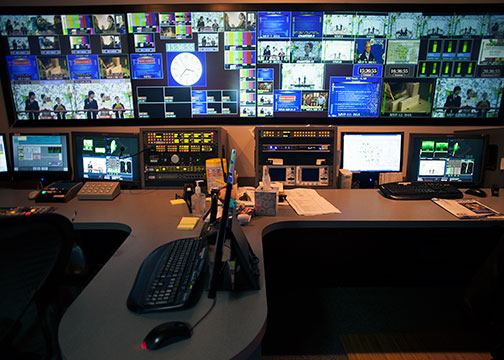Behind-the-Scenes: From Towers to You
December 26, 2014 Leave a Comment
Tuning into Wisconsin Public Television can seem as simple as a click of the remote, but bringing broadcast television to your living room is an ever-changing beast that is always in movement.
A host of engineers, electricians and programmers are constantly at work behind the scenes, making sure that every detail of each show comes to you in clarity. All over the state, our employees are tinkering and tweaking the technology that keeps our vast and complicated system up and running efficiently. Recently, I was lucky enough to visit WPT’s operations center, or OPC, and speak with some of the crazy people who dedicate each day to bringing everything together.
“We have a lot of people,” says Gene Purcell, Executive Director of the Educational Communications Board. “We’ve got 40 sites to take care of and we can’t do it all out of this building, so we’ve got field staff scattered throughout the state. There’s always something going on out there.”
The Broadcast Interconnect, or BIC for short, is one of the largest pieces of the puzzle, and is made up of a series of fiber cables. About 1200 miles of these cables bring WPT’s broadcast to regions all over the state, with studio transmitter link and microwave transmission filling in the gaps, going to areas where fiber cable can’t reach. As with any large, extraordinarily complicated network, the BIC can be a bit of a handful.
“BIC is always there, it’s always on, and it always has a problem,” Purcell says. “There’s always someone working on the BIC.”
Thankfully, WPT has a dedicated team making sure that everything behaves properly. Out in the wild woods of Wisconsin, engineers and maintenance contractors are constantly on call to help with a host of issues. They make sure that lightbulbs are changed, transmissions are going through properly and equipment is updated. They even ward off copper thieves, stray bears and the occasional illegal base-jumper, making sure that each tower and station is safe and secure.
Bringing the story back to the OPC, Jim Blaubach, Operations Manager at WPT, showed me into a room that I could only equate to the bridge of the Star Trek Enterprise. WPT’s master control is comprised of a wall covered with dozens of screens displaying our satellite broadcasts, with panels of blinking lights, buttons and knobs that cover every desk.
The OPC is the heart of WPT’s network, and is almost constantly manned. Broadcasts from PBS are downlinked here, and an entire room of servers produces a constant, vibrating thrum of white noise. This building and the years of data stored here are a reflection of how much our field has changed recently.
“When I started in this business, the OPC was all tape decks and turn tables,” Purcell says. “Now it’s all computers and servers. It’s more and less interesting at the same time, but it’s totally different than it was 10 years ago. It will be totally different in another 10 years.”
Josh Gillman, one of the engineers at the OPC, explains that the center acts as a hub for all of the information that goes into each broadcast, including audio, graphics, local footage and national shows.
“Things don’t originate entirely from one place,” Gillman says. “This show, for example, is coming from BBC, going to California, then to headquarters in Virginia and then it comes to us.”
Much of the broadcast system is automated, pulling logs from staff working on UW-Madison’s campus, but engineers at the OPC always retain the ability to make changes in an emergency. If there was a weather emergency, for example, someone at the OPC would be able to put up a graphic or change the feed slightly in order to broadcast breaking news to Dane County viewers.
The OPC is also home to most of the hard copies of log records required by the FCC. The building is incredibly secure, with a backup generator and a fail-safe UPS, or uninterruptible power supply, that will keep the system running in case of an emergency while the generator fires up. WPT is even able to monitor remote sites across the state, checking on the buildings’ access and temperature to make sure everything is working properly. If need be, maintenance staff are on call.
Is your head swimming? Mine is! This is a ton of information, and our system of servers, fibers and satellites is mind-boggling. Just know that you – our viewers – are our number one priority. Every time you pick up your remote and turn to one of our channels, you’ve got a whole team of people backing you up, making sure that our content is there when you need it.
Wisconsin Public Television Wisconsin Public Television Behind the Scenes
 Passport
Passport







